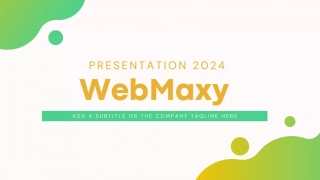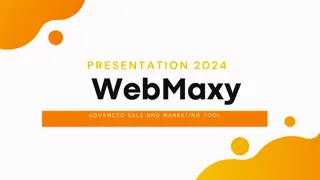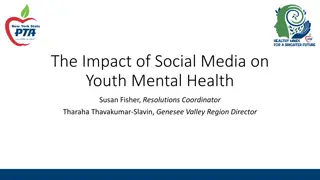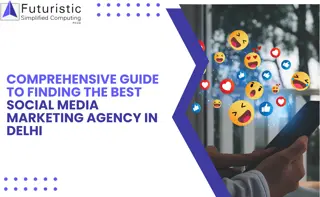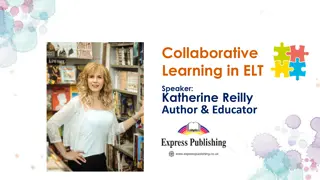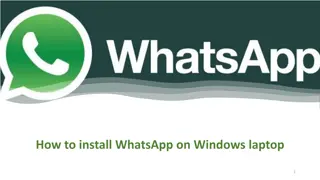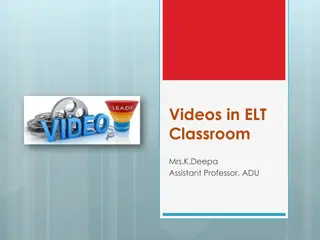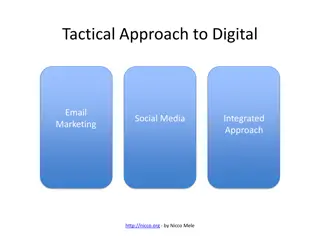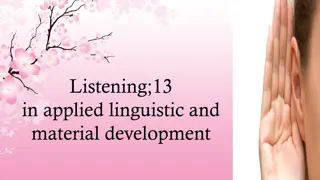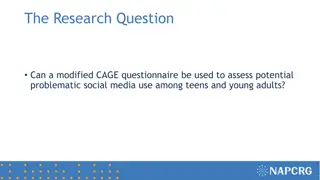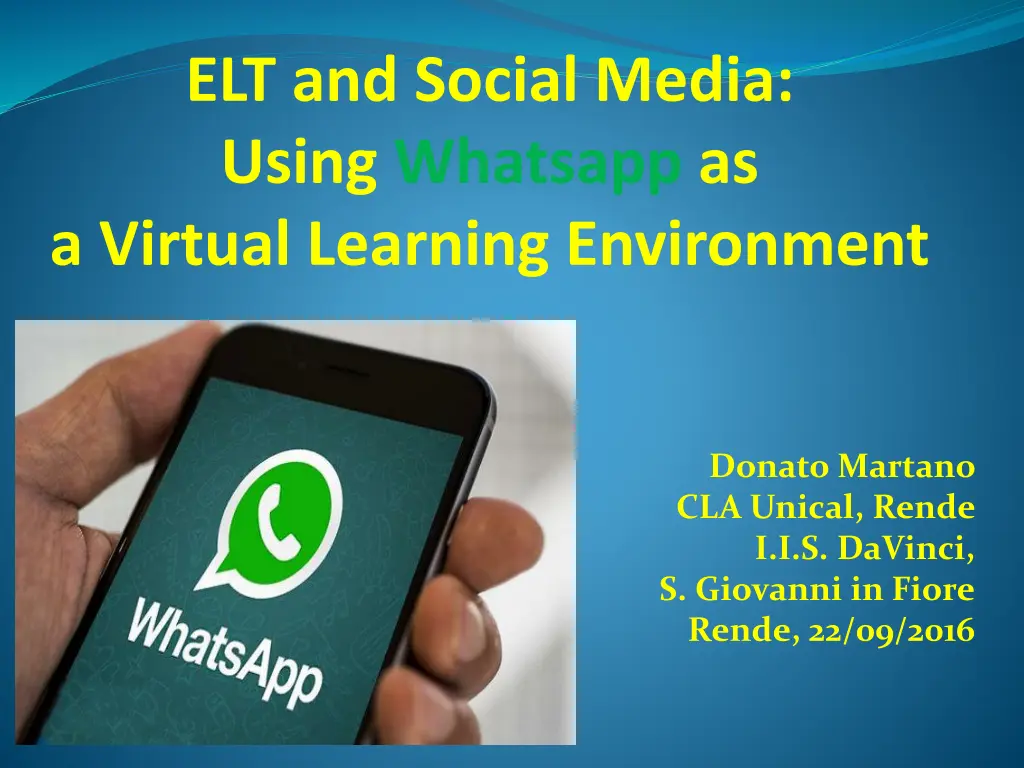
Using Whatsapp as a Virtual Learning Environment in ELT and Social Media
Explore the integration of Whatsapp as a Virtual Learning Environment in the field of English Language Teaching (ELT) and Social Media. Discover the key points of this innovative approach, including formal vs. informal learning, SNS utilization, and the advantages and disadvantages for students and teachers. Delve into the classification and characteristics of Virtual Learning Environments (VLEs), shedding light on the dynamic nature of learning platforms in today's educational landscape.
Download Presentation

Please find below an Image/Link to download the presentation.
The content on the website is provided AS IS for your information and personal use only. It may not be sold, licensed, or shared on other websites without obtaining consent from the author. If you encounter any issues during the download, it is possible that the publisher has removed the file from their server.
You are allowed to download the files provided on this website for personal or commercial use, subject to the condition that they are used lawfully. All files are the property of their respective owners.
The content on the website is provided AS IS for your information and personal use only. It may not be sold, licensed, or shared on other websites without obtaining consent from the author.
E N D
Presentation Transcript
ELT and Social Media: Using Whatsapp as a Virtual Learning Environment Donato Martano CLA Unical, Rende I.I.S. DaVinci, S. Giovanni in Fiore Rende, 22/09/2016
Keywords EFL/ESL = English as Foreign/Second Language TELL = Technology Enhanced Language Learning MALL = Mobile Assisted Language Learning LMS = Learning Management System VLE = Virtual Learning Environment SNS = Social Networking Sites NBLT= Network Based Language Teaching 10/06/2025 Donato Martano, Using Whatsapp... 2
Key Points of the Presentation Formal vs Informal Learning Virtual Learning Environments SNS and ELT Whatsappas a VLE Students and Teachers in chat Advantages and Disadvantages SNS in Higher Education 10/06/2025 Donato Martano, Using Whatsapp... 3
Formal Learning Occurs in official settings (school, college, university) Part of a defined curriculum Planned structure, schedule, objectives and expected outcome Subject to formal assessment/evaluation 10/06/2025 Donato Martano, Using Whatsapp... 5
Informal Learning No dedicated setting No defined content, timing, instructions No set objectives or outcome Not intentional from the learner s perspective Learning byexperience, includes language building, socialization and play 10/06/2025 Donato Martano, Using Whatsapp... 6
Virtual Learning Environments Formal: static and structured, with lessons and practice/assessment sections. Online tutoring and chat/forum as extra features. Often mandatory. Semi formal: provide both structured parts or courses and extra resources/activities chosen autonomously by the user. Informal: No predetermined path, users participate in the VLE according to their preferences. 10/06/2025 Donato Martano, Using Whatsapp... 8
Classification of VLE J. Park (2011) classifies mobile learning applications confronting two factors: 1) HIGH vs LOW Transactional Distance (Moore, 1993) 2) INDIVIDUALIZED VS SOCIALIZED learning activity SNS can be considered LowTD/Socialized VLEs 10/06/2025 Donato Martano, Using Whatsapp... 9
Integrating SNS in class courses G. Mallia (The Social Classroom, 2014) posits 4 ways of integrating SNS: INTEGRATED APPENDED SUPPORTIVE RANDOM The difference lies mainly in the degree of involvement in the course structure 10/06/2025 Donato Martano, Using Whatsapp... 11
4 ways of Integrating SNS INTEGRATED: teacher imparts instructions on SN use; SN pages explicitly part of the designed course. APPENDED: SN pages as continuation/reinforcement of class work. Participation expected, not mandatory. SUPPORTIVE: participation encouraged, not expected; incidental nature, in line with common usage of SN; likely to be accepted by SS RANDOM: completely incidental reference to the course. Mainly used for class management, incidence difficult to map. 10/06/2025 Donato Martano, Using Whatsapp... 12
Social Network Users the very nature of most social networks is informal ( ) social networks are used because users want to, rather than because they have to (Mallia, The Social Classroom, 2014, Preface) ( ) three main dimensions motivate the choice of joining a social network: the information dimension, the friendship dimension and the connection dimension (Bonds Raacke & Raacke, 2011) 10/06/2025 Donato Martano, Using Whatsapp... 13
The study Creation of class groupchat in English (4 groups) Students age from 16 to 20 Mixed level, ranging between A1 and B1 Duration: from 1 month to 3 years 10/06/2025 Donato Martano, Using Whatsapp... 15
Key aspects of Whatsapp as a VLE The most popular instant messaging app Class Management Tool (notices, assignments, reminders, materials) Communication-oriented Favorsacquisition rather than learning (Krashen 1982 Input Hypothesis); Informal, relaxed, anxiety-free (no requirements or expectations) 10/06/2025 Donato Martano, Using Whatsapp... 16
Whatsapp features Receive and send text messages View members status and profile pic Share media content (documents/ images/ videos / music / links) Useemoji and symbols in writing Record and receiveaudio messages 10/06/2025 Donato Martano, Using Whatsapp... 17
Extra supporting tools T9 Text prediction Spellchecker Easy to integrate with extra apps and tools (online dictionaries, pronuciation check) Internet search 10/06/2025 Donato Martano, Using Whatsapp... 18
Language and interaction Whatsapp is suitable for beginners because: Members normally exchange SHORT messages Basic language, roughly tuned Real communicational needs (sharing info, making appointments, small talk, class management) 10/06/2025 Donato Martano, Using Whatsapp... 20
Students INPUT RECEIVERS/PRODUCERS silence admitted until they feel ready IMITATE input produced by teacheror peers ATTEMPT tocommunicate CREATE CONTENT by sharing materials REQUIRE FEEDBACK from teacheror peers 10/06/2025 Donato Martano, Using Whatsapp... 21
Teacher INPUT PROVIDER/TUNER FEEDBACK PROVIDER (when required) FACILITATOR provides scaffolding SILENT MONITOR observer (Gentle) PROMPTER ADMINISTRATOR establishes rules 10/06/2025 Donato Martano, Using Whatsapp... 22
Dealing with errors in a group chat Self Correction - *oops Peer Correction Teacher s feedback 10/06/2025 Donato Martano, Using Whatsapp... 23
Advantages Turn mobile phones from source of distraction into learning tools Expand class time and exposure to L2 Supportclass management Increase students motivation and confidence 10/06/2025 Donato Martano, Using Whatsapp... 25
Familiarity with the medium Agarwall (2011) Ease of use and intuitive interfaces of Social Media technologies ( ) require zero to minimal training for learners ( ) most individuals are already using the social media, and this makes blending them with a learning environment simple and rational 10/06/2025 Donato Martano, Using Whatsapp... 26
Knowledge co-construction Real-time chat and data sharing applications support communication, collaboration and knowledge construction. (Koole, 2009, p. 26) Structures of learning are built ( ) also by collective learners; dialogue is formed ( ) among the learners themselves. (Benson & Samarawickrema , 2009) 10/06/2025 Donato Martano, Using Whatsapp... 27
Relevance for Students Students are key actors of the learning process, feel important and trusted. (Humanistic Education, Rogers 1969) Meaningful interaction Builds identity and sense of belonging to a community Promotes cooperation and communication among SS Relatively low level of self disclosure 10/06/2025 Donato Martano, Using Whatsapp... 28
Disadvantages Impact on learning difficult toestimate or assess Didactic misbehaviour (OT, overuse of L1) Social misbehaviour (quarrels, bullying, abusive language) Privacy issues (intrusiveness, obsessive chatting, stalking) Indefinite amount of extra work 10/06/2025 Donato Martano, Using Whatsapp... 29
Precautions Establishing a group netiquette Being discreet and alert at the same time Using a dedicated phone number/device Silencing groupchats Shutting down the phonewhen necessary 10/06/2025 Donato Martano, Using Whatsapp... 30
Using SNS in Higher Education? Academics participation in SNS ( ) blend social grooming, identity building, networking and assistance provision-request (Veletsianos, Aspioti and Aspiotis, 2010) Informal learning experiences present alternative means of engaging students in academic content without the time constraint of the formal curriculum (Bull, Thompson and Searson, 2008, p 126) 10/06/2025 Donato Martano, Using Whatsapp... 32
(In)formal Learning at Unical: The English Corner (tutoring forstudents of Engineering, 2009) Self Study Activities (Multimedia Language Lab) CLAC Project -Language Courses for International Certifications (Students, PhDs, School Teachers, 2009 -2013) Conversando (2014/2015) (Conversation Classes held by International Students at Unical) 10/06/2025 Donato Martano, Using Whatsapp... 33
Final Remarks Implementing informal learning within formal learning contexts enhances students motivation and can improve performance SNS are particularly suitableVLEs to be used as a continuation of class activities Whatsappas a VLE offers a numberof advantages (ease of use, basic interaction, integrating skills, extra tools) Some precautions must be taken by the teacher, particularlyconcerning privacy issues Informal VLEs such as SNS can be implemented effectively in Higher Education contexts 10/06/2025 Donato Martano, Using Whatsapp... 35
10/06/2025 Donato Martano, Using Whatsapp... 36
Bibliography Agarwall, N., 2011, Collective Learning: an Integrated use of Social Media in Learning Environment. In B. White, I.King,P. Tsang (Eds), Social media Tools and Platforms in Learning Environments, Berlin, Springer- Verlag Benson, R., Samarawickrema, G. (2009). Addressing the context of e-learnimg: using transactional distance theory to inform design. Distance Education, 30 Bonds-Raacke, J., and Raacke, J. (2010), My Space and Facebook: Identifying Dimensions of Uses and Gratifications for Friend Networking Sites, Individual Differences Research, 8 Koole, M. L. (2009). A model for framing mobile learning. In M. Ally (Ed.), Mobile learning: Transforming the delivery of education and training (pp. 25-47). Edmonton, AB: AU Press, Athabasca University. Krashen, S., Principles and Practice in Second Language Acquisition, 1982, Oxford, Pergamon Press Mallia, Gorg (ed.) (2014), The Social Classroom: Integrating Social Network Use in Education,, ISR IGI Global, Hershey PA, USA Moore, M. G. (2007). The theory of transactional distance. In M. G. Moore (Ed.), Handbook of distance education (pp. 89-105). Mahwah, NJ: Lawrence Erlbaum Associates. Park, J, 2011, A Pedagogical Framework for Mobile Learning: Categorizing Educational Applications of Mobile Technologies into Four Types, International Review of Research into Open and Distance Learning, 12.2, Rogers, Carl , (1969) Freedom to Learn. Columbus, Ohio: Charles E. Merrill. Veletsianos, G. (Ed) (2010), Emerging Technologies in Distance Education, Athabasca University Press Vygotsky, L. S. (1978) Mind in society: The development of higher psychological processes. London: Harvard University Press. 10/06/2025 Donato Martano, Using Whatsapp... 37

